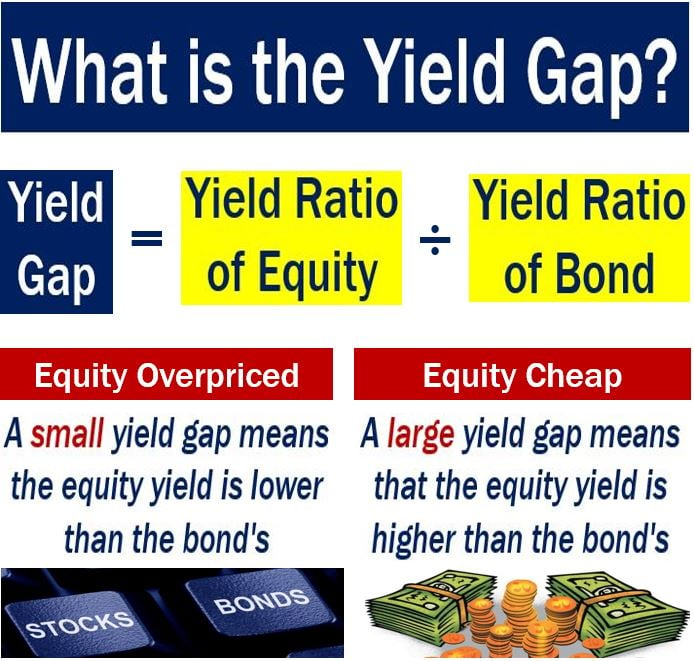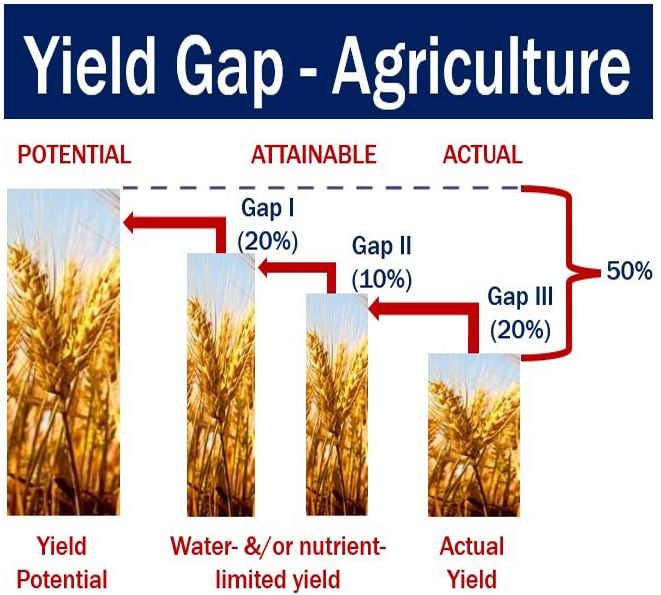Yield gap – definition and meaning
The Yield Gap is a term that is used in investments and agriculture. It is a method of comparing the performances of shares and bonds – it is the average **yield on shares minus the average yield on bonds. The yield gap, in agriculture, is the difference between yield potential and average farmers’ yield over a specified area and period.
** Yield = the amount of money that an investment generates in percentage terms, in cash.
This disparity not only reflects variances in agronomic practices but also the varying degrees of access to agricultural technology and resources across different regions.
The first half of this article focuses on the term when it is used in the world of business and finance, while the second half contains data on its meaning in agriculture.
The yield gap is the difference between the yield on government bonds – specifically long-term ones – and the dividend yield – the yield on shares – at any given time.
According to Lexicon.ft.com, the Financial Times’ dictionary of business and financial terms, the yield gap is:
“The difference between the yield on long-term government bonds and the yield on shares (dividend yield) at any given time.”
 In the world of investment markets, it is used to determine whether shares (equity) are too expensive or cheap.
In the world of investment markets, it is used to determine whether shares (equity) are too expensive or cheap.
Yield gap – markets
The yield gap is only used when looking at bonds and shares in the same market – when you are comparing the difference between the average dividend and bond yields.
MoneyTerms.co.uk says that by ‘markets’, we would generally mean either the national or global markets for equities and bonds.
It is a useful measure of a stock market’s valuation, and can also indicate whether a market is under- or over-valued. Abnormal yield gaps can be justified by greater or smaller growth expectations.
MoneyTerms.co.uk makes the following comment regarding the yield gap and time:
“The yield gap is also changes over time in response to changing conditions. For example, if companies commonly choose to increase share-buy backs rather than dividends, the yield on shares will fall.”
“There are a number of reasons why companies might choose to do this, including tax structures, and the widespread tying of directors’ remuneration to share prices.”
 VillFarm.com has the following definition: “We recognize yield gap to be the difference between the potential yield of a given crop at a given location and the actual yield realized by farmers for a given reference climatic condition.” (Image: data source villfarm.com)
VillFarm.com has the following definition: “We recognize yield gap to be the difference between the potential yield of a given crop at a given location and the actual yield realized by farmers for a given reference climatic condition.” (Image: data source villfarm.com)
Yield gap – agriculture
The yield gap is the difference between a current farm’s crop yield and what it could potentially yield if it were well run and had the proper technology.
Yield gap is used to describe the huge gulf between the crop yields of the world’s most productive farmers and the least successful ones.
For example, American farmers typically grow up to five times as much corn per acre as their counterparts do in Africa.
In a New York Times blog, dated June 7th, 2011 – ‘Can the Yield Gap be Closed – Sustainably?’ – Justin Gillis quoted experts who said that closing the yield gap is crucial if we want to feed the world over the long term.
Regarding how to close the yield gap, Mr. Gillis wrote:
“And there is no technological mystery about how to do it: the strategy of using high-yielding modern crop varieties and nitrogen fertilizer has already been proven, in the Green Revolution, to raise output for farmers.”
“But getting these tools into the hands of poor smallholder farmers requires both political leadership and large public investment.”
China has managed to transform itself from a famine-plagued nation to one that today is able to feed itself. India and Pakistan, to a significant extent, have also managed to make the transition.
The vast majority of African governments, however, have failed – partly because of poor leadership and a chronic lack of funds.
Indicators Report has the following definition for yield gap:
“Actual yields relative to the yield that can be achieved under good management conditions, taking into account climate and the sustainable use of water (i.e. water-limited yield potential).”
Indicator Report says that nations should aim for the majority of their farms to achieve at least eighty percent of the attainable water-limited yield potential. In order to achieve this – on a sustainable basis – governments need to implement the right policy and technology road-maps.
Advancements in precision agriculture and data analytics are showing promise in narrowing the yield gap by enabling farmers to optimize inputs and increase efficiency.
Compound phrases containing “yield gap”
A compound phrase is a term that consists of two or more words. “Yield gap” is a compound phrase. Here are some 3-word compound phrases containing the term “yield gap.” They are all related to methods of understanding, addressing, or utilizing the yield gap in agricultural practice:
-
Yield Gap Analysis
A study to quantify the difference between potential and actual yields and identify the factors causing this gap.
For example: “The agricultural department’s yield gap analysis revealed that the primary cause of reduced productivity was a lack of access to advanced irrigation systems.”
-
Yield Gap Mapping
The process of creating geographical representations of yield gaps to visualize where the greatest discrepancies occur.
For example: “Through yield gap mapping, the team was able to target specific areas for agricultural development programs.”
-
Yield Gap Reduction
Efforts and methods applied to decrease the difference between the potential and actual yields.
For example: “The new fertilizer proved crucial for yield gap reduction, bringing the farmers’ harvests closer to the regional potential.”
-
Yield Gap Assessment
Evaluation of the yield gap to determine the best approaches for improving crop production.
For example: “The non-profit’s yield gap assessment in the region prompted the introduction of drought-resistant seeds to enhance crop output.”
-
Yield Gap Benchmarking
The process of comparing yield gaps across different regions or farming systems to establish performance standards.
For example: “By utilizing yield gap benchmarking, the research institute could set realistic targets for sustainable crop intensification.”
Video – What is the Yield Gap?
In this visual guide presented by our affiliate channel, Marketing Business Network on YouTube, we explain what “The Yield Gap” is using straightforward language and easy-to-understand examples.

